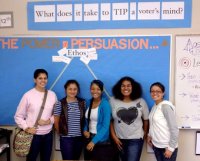Resources for Designing a Political Ad Campaign Project
Your content has been saved!
Go to My Saved Content.I learned that you can lie and people will believe you. -- Greg, an eleventh grade student.
This statement would shock most people but his teachers were proud. Greg, a student at Metropolitan Arts and Technology High School in San Francisco (an Envision School), and his classmates had just finished presenting their California Proposition Campaign Ads. Greg’s reflection met one of many outcomes: that by producing media, students will become better consumers of media -- especially election campaign advertising. Suzie Boss highlighted this project and other election projects in this Edutopia blog. I’d like to offer below an explanation and tools if you would like to replicate this project at your school. Here is a video overview of the project produced by the Pearson Foundation.
The Political Campaign Ad project was originally created by the Communications Academy at Sir Francis Drake High School in California’s San Anselmo. Here is an example from the 2010 election title, "No on Prop. 23."
The Assignment
The Political Campaign Ad Project has been adapted by the Metro since the election of 2006. By answering the Essential Question: What is the most effective persuasive technique used by the media to “tip” voters’ minds? The Campaign Ad Project serves as a powerful tool for students to engage in the election especially since some will be voting for the first time the rest will soon join our officially join our political process. It also provides relevance for the study of US History, Government and/or English. In addition to a one-minute video campaign advertisement, students also produce a college ready, 5-6 page argumentative essay as part of the preparation to create a video. Here are the instructions this year to the students from their English teacher, Abby Benedetto:
You have spent the past several months taking a hard look at how the media employs persuasive techniques in targeted ways to try and change the public’s mind about people and issues. At the same time, we have been reading about the critical factors that help to “tip” ideas, products, and movements from just a fad to a trend or an epidemic. You must now synthesize all of that learning into an argumentative essay that lays out your best analysis of the most powerful persuasive technique, and the effect it can have.
You will incorporate evidence from multiple media advertisements, any of the articles we have read in class, as well as excerpts from Malcolm Gladwell’s The Tipping Point to support your claim. This argumentative essay will serve as your endorsement of the most powerful persuasive technique used in written or visual communication.
Your job is to think critically about the various persuasive techniques that you saw used in this campaign by the media as well as what your group used in your own campaign ad. You will identify what you believe to be the most effective technique, and support why it is effective and what result it had on the campaign and the public. You will then draw connections between this technique and its effects to one of the three rules of The Tipping Point in order to make conclusions about how that persuasive technique could cause a campaign to “tip.”
Successful projects often have an authentic audience. The Campaign Ad project has the ultimate relevant audience: voters hungry for information and clarity. Because the students exhibit their ads the evening before the election, the project also serves as a great service to voters who often have difficult time discerning the complicated California Initiative propositions. The students serve as resources before and after presenting their Campaign Ads to an audience that often number close to 200 adults. The news media love this project too. (Here's a 2008 news clip from the local ABC affiliate in the Bay Area.)
The Resources
It is not too late to make this project happen for your students! Below are resources so you can adapt and implement. A special thanks for Justin Wells (former Metro teachers) and Abby Benedetto (current Metro teacher) for sharing their materials for this project. Here’s the Campaign Ad Project Website, complete with exemplars.
You can also download some of the most useful materials here.
If you decide to implement this project, please post a link to your student work. I will post a link to the 2012 Metro Campaign Ads following the election.
